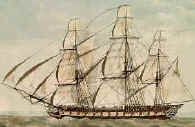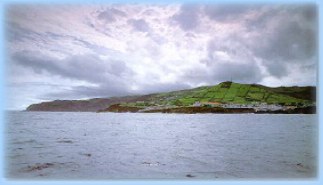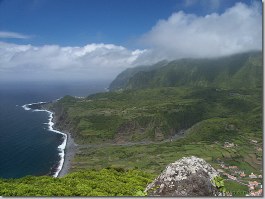Footsteps Through Time | Home
Dedication and Welcome to My Website | Our Lineage | My Story | My Husband and his Family | Our Children | Our Grandchildren | My Dog | Family Researchers | Mom's Family | Dad's Family | Pets | My Grandparents | My Great Grandparents | Charles William Cole | Where Charlie served | Charles William Cole's Parents | The Ancestors of Charles William Cole | Ireland - The Emerald Isle | The Western Isles - The Azores | The Founders of Rhode Island | The Americans - Rhode Island | The Americans - Massachusetts | The Settlers | The Settler's Stories | New England Graves | They Fought for America | The New Comers | The New Comer's Stories | They Left England | The Emigrants | Olde England | The English | Connections to Distant Past | The Normans | English Knights | From the Northern Seas | And Beyond
The Western Isles - The Azores (The Azores)

Far out in the Atlantic Ocean, half way between Portugal and America, tiny islands emerge from a blue horizon. These are the Azores, sometimes called the Western Islands. For generations, my ancestors were born, lived and died on these islands. During the last century, some left and ventured across that wide blue expanse of ocean to America.
This is their story.

Manuel Bettencourt Silva, my great grandfather, made the journey aboard a whaling ship from the island
of Sao Jorge to New Bedford, Massachusetts in the year 1870.
History of Sao Jorge
The first reference to the island of São Jorge was made in 1439 but the actual date of discovery is unknown. In 1443 the island was already inhabited but active settlement only began with the arrival of the noble Flemish native Wilhelm Van der Haegen. Arriving at Topo, where he lived and died, he became known as Guilherme da Silveira to the islanders. João Vaz Corte Real received the captaincy of the island in 1483. Velas became a town before the end of the 15th century.
The São Jorge economy at this time was based on wine making, wheat production, pastel dyers woad and canary moss “urzela”. Canary moss and dyers woad were exported to Flanders and other European countries.
In 1510 Calheta became the seat of the municipality and in 1534 Topo and was also elevated to municipal seat.
During the uneasy period when King Philip II of Spain rose to the Portuguese throne, the people of São Jorge continued to supported
Dom António do Crato unconditionally and continued to confront the Spanish even after the fall of the island.
Throughout the 16th, 17th and 18th centuries São Jorge was also attacked by English and French pirates
while coveted by both Turkish and Algerian pirates.

Anna deJesus Gomes, his future wife, boarded a ship in Lajes, Flores and arrived in Boston, Massachusetts three years later.
Flores and Corvo
The two islands that comprise the eastern islands were the last to be discovered.
Flores and Corvo were discovered close to the year 1452 by Diogo de Teive and his son João de Teive.
The island of Flores (flowers) was initially called St. Thomas and St. Iria but due to the abundance of yellow flowers (cubres)
which covered the island the new name was considered to be more appropriate.
The Flemish nobleman Wilhelm Van der Haegen, settled Flores in 1470 at “Vale da Ribeira da Cruz”.
The distances that separated it from the other islands in addition to the lack of inter island transportation for the export of pastel to Flanders
forced him to abandon the island and settle in São Jorge.
In the beginning of the 16th century the remaining settlement grew and the lands were cultivated for the production of wheat, barley,
corn and vegetables all for consumption on the island.
In 1515 Lajes becomes a town and in 1548 Santa Cruz receives the same distinction.
Corvo, known in the past as “Insula Corvi Marini”, is the smallest island with a surface face area of 17 km2 and survives, even today, through farming.
American whalers in the Azores at the end of the 18th and 19th centuries used many crewmen from Corvo.
Their acts of bravery and daring are well recorded and greatly appreciated by the American whalers.
Many of these Corvians, seduced by a better way of life later remained in America, a situation that increased the level of emigration from Corvo.
Presently the only urban centre in Corvo and the seat of the municipality since 1832, is “Vila Nova”.
It harbours a population of approximately 370 inhabitants.

Mary Jacintho Bicho, her daughter Rosa Jacintho daCosta and her two children, Mary daCosta and my twelve year old grandfather, Alfredo Jacintho daCosta, left Santa Cruz, Flores in 1892. They settled in Providence, Rhode Island that same year.
Francisco daCosta was born on the island of Sao Miguel in the Azores. I do not know the date of his death or if he emigrated to America before his wife and children. He died before 1900.
Sao Miguel
According to certain historic reports the island of São Miguel was populated in 1444. The populace that disembarked in Povoação came from the “Estremadura”, “Alto Alentejo”, “Algarve” (all continental Portugal), and other foreign countries, specifically France.
Gonçalo Velho Cabral was the dominant force in bringing these people to São Miguel.
They spread themselves along the coastline in areas where conditions of accessibility and farming were best.
The fertility of these islands in the middle of the Atlantic contributed to the strong economic expansion in São Miguel. Production and export of wheat to the Portuguese
garrison in North Africa and of sugar cane and dyes to Flanders gave the primary commercial impetus. Later oranges were grown and exported to England.
At the end of the sixteenth century and the beginning of the seventeenth century, São Miguel provided the centre stage for French, English, and Algerian pirate attacks.
In 1582 the island was occupied by Spanish troops which succeeded in defeating the French army. Although the French were fighting with the help of the Portuguese troops
led by Dom António, prior of Crato (His Priorship-candidate for the Portuguese throne), they failed to suppress the attack. Finally in the month of December in 1640, national independence was restored and the islands were returned to the Portuguese monarchy.
The first capital of São Miguel was Vila Franca do Campo. Due to a violent earthquake in 1522 that buried the town of Vila Franca, Ponta Delgada was
designated capital of the island. Ponta Delgada, 25 kilometres west of Vila Franca was already the centre of the municipality and became the first city
on the island in 1546.
The settlement at Ribeira Grande, situated 18 km from Ponta Delgada, received the charter of town in 1507 by Dom Manuel (King of Portugal).